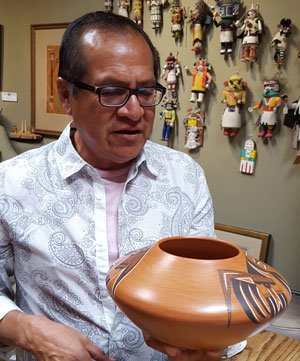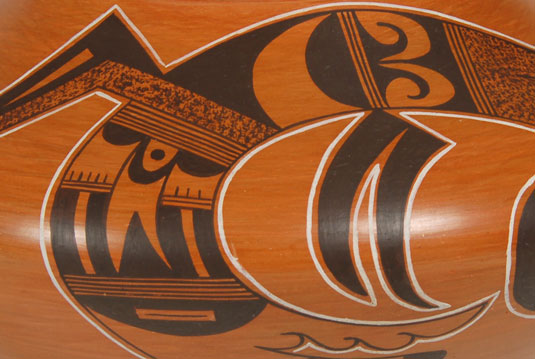Black on Red Hopi Seed Jar [SOLD]
+ Add to my watchlist Forward to Friend
- Category: Modern
- Origin: Hopi Pueblo, Hopituh Shi-nu-mu
- Medium: clay, pigment, kaolin
- Size: 4-3/4” height x 9-1/4” diameter
- Item # 25863 SOLD
 Mark Tahbo has surprised us again. He brought us a Hopi seed jar different from any he has shown us before. Normally, all of his jars are made in that beautiful orange blush that most Hopi potters produce. This jar, however, is one of the older styles executed in red. Mark said he got the idea of using a different clay to see if he could produce a jar in tribute to famous Hopi potter Garnet Pavatea. Garnet seemed to prefer using “yellow clay” that was available just below the mesa top at First Mesa, a source no longer accessible. It became necessary to construct a wall over the clay source to prevent that area of the mesa from collapsing.
Mark Tahbo has surprised us again. He brought us a Hopi seed jar different from any he has shown us before. Normally, all of his jars are made in that beautiful orange blush that most Hopi potters produce. This jar, however, is one of the older styles executed in red. Mark said he got the idea of using a different clay to see if he could produce a jar in tribute to famous Hopi potter Garnet Pavatea. Garnet seemed to prefer using “yellow clay” that was available just below the mesa top at First Mesa, a source no longer accessible. It became necessary to construct a wall over the clay source to prevent that area of the mesa from collapsing.
Garnet was a famous potter at First Mesa and was eagerly collected by the curator at the Museum of Northern Arizona, who recognized her historical significance. Mark, too, feels she was a very important influence on Hopi pottery and wished to honor her with a jar in her style.
The red finish on a Hopi jar comes from using a mustard yellow clay that now has to be found at Second Mesa since the First Mesa source is no longer available. Residents of Second Mesa discourage those from First Mesa from searching for clay, so it is difficult for potters to use yellow clay anymore. A relative of Mark’s who lives at Second Mesa was able to assist him in acquiring only enough for a single jar.
When the yellow clay is fired, it changes to an orange-red color often seen in older Hopi pottery but rarely seen today because of the scarcity of the yellow clay. Mark chose the clay in honor of Garnet Pavatea but selected a vessel shape in honor of Nampeyo. One can see the similarity of the shape of this jar to ones by Nampeyo.
 To further his tribute to older Hopi potters, Mark chose a design style often used by Annie Healing Nampeyo. Annie frequently used black designs outlined in white, as did Garnet Pavatea. Mark placed two stylized Sikyatki birds on the jar, each bird occupying a large space from the rim to the base. He deliberately omitted framing lines so the birds would not be squeezed into the area but left free to occupy the most space.
To further his tribute to older Hopi potters, Mark chose a design style often used by Annie Healing Nampeyo. Annie frequently used black designs outlined in white, as did Garnet Pavatea. Mark placed two stylized Sikyatki birds on the jar, each bird occupying a large space from the rim to the base. He deliberately omitted framing lines so the birds would not be squeezed into the area but left free to occupy the most space.
In one of the bird designs, Mark outlined the exterior of the bird with white paint made from Kaolin. In the other bird, he used white on the interior lines of the bird. Both birds are black, achieved from a mixture of hematite and bee weed. As always, the entire designs were applied using a brush made from a yucca leaf.
It is so refreshing to see a potter always strive to achieve more from his talent, rather than constantly producing the same product because it has a known sales appeal. Mark is unique in that he constantly seems to be pushing himself to do better work and to produce different and unique pottery, far from the ordinary. It is a pleasure to see what he brings to us and to listen to his explanation of each step in the process and the reason he chose to do what he did.
Condition: new
Recommended Reading: Hopi-Tewa Pottery: 500 Artist Biographies by Gregory and Angie Schaaf
Provenance: from the artist

- Category: Modern
- Origin: Hopi Pueblo, Hopituh Shi-nu-mu
- Medium: clay, pigment, kaolin
- Size: 4-3/4” height x 9-1/4” diameter
- Item # 25863 SOLD



